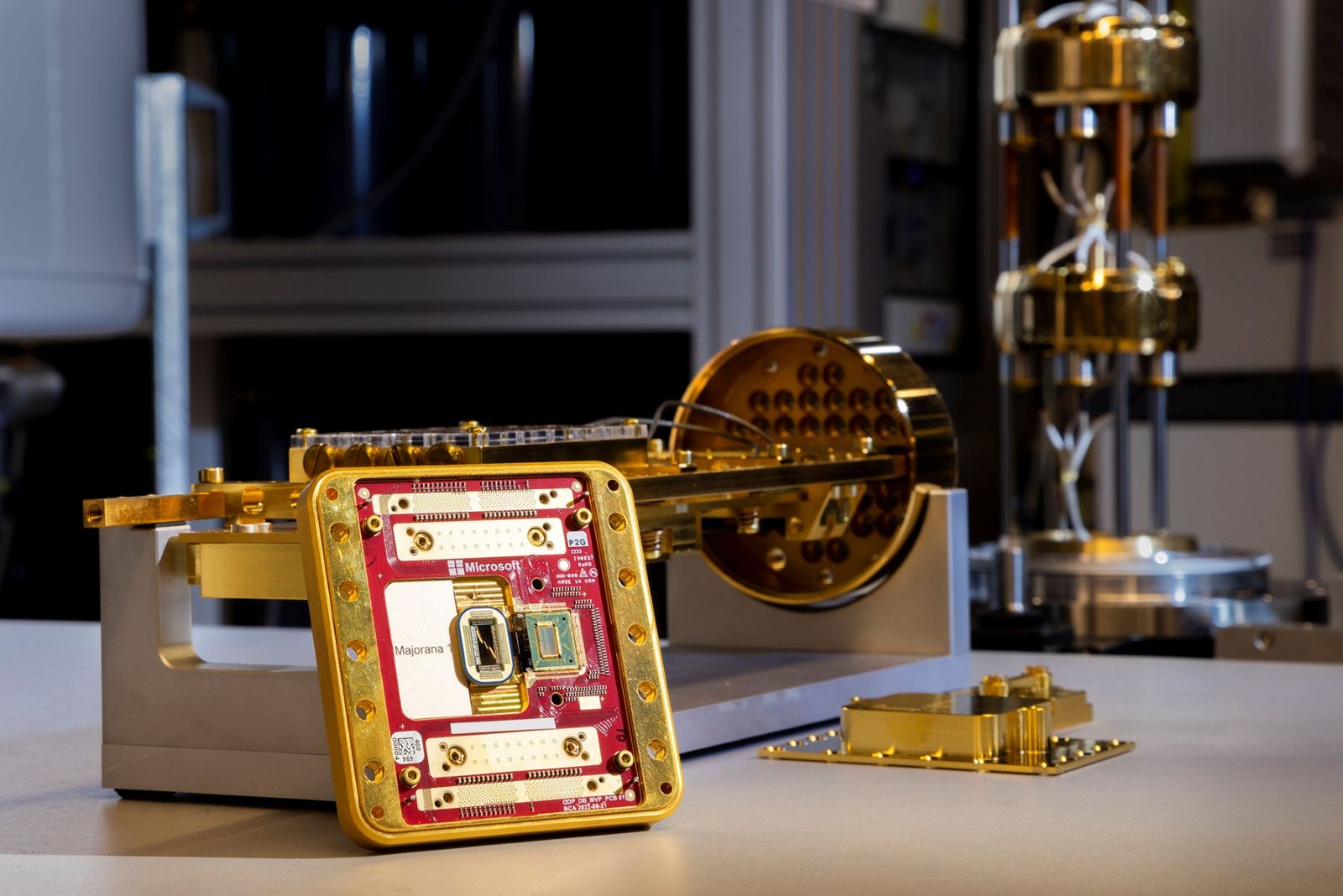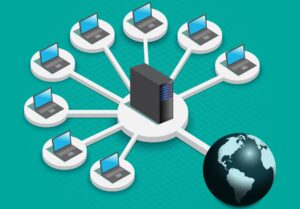Picture this: a computer so powerful it could crack a code in minutes that would take today’s fastest machines longer than the age of the universe to solve. That’s not a sci-fi dream—it’s the promise of quantum computing. Unlike the traditional PCs we use for emails, gaming, and work, quantum computers tap into the bizarre rules of quantum mechanics to process information in ways that defy our everyday understanding. But what really separates these two technologies?
In this article, we’ll break down the differences between quantum computing and traditional PCs, exploring their inner workings, strengths, and potential to shape our future. Along the way, we’ll spotlight Microsoft’s groundbreaking Majorana 1 processor, a recent leap that could bring quantum computing closer to reality. Whether you’re a tech newbie or a seasoned geek, get ready to dive into the next frontier of computation—where bits meet qubits, and the impossible becomes possible.
On This Page
Table of Contents
1. The Basics: How Traditional PCs Work
Let’s start with what we know. Traditional PCs—your laptops, desktops, and even smartphones—rely on binary computing. Everything boils down to bits, tiny units of data that are either a 0 or a 1. These bits are processed using transistors, microscopic switches packed into chips like CPUs and GPUs.
- How It Works: A transistor flips on (1) or off (0) based on electrical signals, chaining together to perform calculations.
- Example: Typing “hello” on your keyboard sends a series of binary codes (e.g., 01001000 for “H”) that your PC translates into letters onscreen.
- Strengths: Fast, reliable, and versatile for everyday tasks like browsing or video editing.
- Limits: As problems get complex—like simulating a molecule—traditional PCs slow down, needing more time and power.
Think of a traditional PC as a super-efficient librarian who can only handle one book at a time, no matter how fast they work.
2. Quantum Computing 101: A New Paradigm
Now, enter quantum computing. Instead of bits, it uses qubits, which are like magic coins that can be heads, tails, or both at once—thanks to a property called superposition.
- Superposition: A qubit can be 0, 1, or a mix of both until measured, letting it explore multiple states simultaneously.
- Entanglement: Qubits can link up, so changing one instantly affects another, no matter the distance.
- Example: Imagine flipping 10 coins at once. A traditional PC checks each flip one-by-one (1,024 combinations), while a quantum computer evaluates all possibilities at once.
This isn’t just faster—it’s a whole new way of thinking, rooted in quantum mechanics, the science of the subatomic world.
3. Speed and Power: Comparing Performance
| Aspect | Traditional PCs | Quantum Computers |
|---|---|---|
| Processing | Linear: one task at a time | Parallel: many tasks simultaneously |
| Speed | Great for simple tasks | Exponential for specific problems |
| Example Problem | Adding 2 + 2 | Cracking encryption codes |
- Traditional PCs: Perfect for word processing or gaming but struggle with massive datasets—like predicting weather patterns for a decade.
- Quantum Computers: Shine in optimization (e.g., finding the shortest delivery route) or cryptography (e.g., breaking RSA encryption in seconds, not centuries).
- Real-World Case: Google’s quantum team once solved a problem in 200 seconds that would take a supercomputer 10,000 years.
Microsoft’s Majorana breakthrough promises to make this speed practical, not just theoretical.
4. Hardware Showdown: Bits vs. Qubits
The guts of these machines couldn’t be more different.
Traditional PCs
- Components: CPUs, GPUs, and RAM—all built with silicon transistors.
- Environment: Works at room temperature, humming away on your desk.
- Example: Intel’s latest Core i9 has billions of transistors, each flipping millions of times per second.
Quantum Computers
- Components: Qubits made from superconducting circuits, trapped ions, or—in Microsoft’s case—Majorana particles.
- Environment: Needs cryogenic freezers (near absolute zero, -459°F) to avoid interference.
- Example: IBM’s quantum systems use superconducting qubits, cooled to a whisper above absolute zero.
- Challenge: Qubits are fragile—vibrations or heat can cause errors, unlike the sturdy bits in your PC.
5. Microsoft’s Majorana Breakthrough: A Leap Forward
In 2025, Microsoft unveiled the Majorana 1 processor, a milestone in quantum computing. It’s based on topological qubits, built using Majorana particles—elusive quasiparticles that could fix quantum’s biggest headache: errors.
- What Are Majorana Particles?: Predicted in 1937, these particles are their own antiparticles, making them ultra-stable.
- The Breakthrough: Microsoft’s topoconductor—a hybrid of superconductors and semiconductors—creates Majorana zero modes, reducing error rates dramatically.
- Why It Matters: Unlike other qubits, topological qubits resist environmental noise, a game-changer for scaling up.
- Example: Think of a tightrope walker. Normal qubits wobble and fall with the slightest breeze, but Majorana qubits are like walking on a wide, sturdy bridge.
This could mean quantum computers move from lab toys to real-world tools sooner than expected.
6. Scaling the Future: From Eight Qubits to a Million
| Scale | Traditional PCs | Quantum Computers |
|---|---|---|
| Current State | Billions of transistors | Dozens of qubits (e.g., IBM’s 127) |
| Goal | More efficient chips | Microsoft: 1 million qubits |
| Impact | Faster phones, laptops | Solving unsolvable problems |
- Traditional PCs: Moore’s Law (doubling transistors every two years) is slowing, but chips keep shrinking.
- Quantum Computers: Microsoft aims for a million qubits by 2030, leveraging Majorana stability.
- Example: A million-qubit machine could simulate a new drug’s effect on every human protein in hours, not decades.
The Majorana 1 is just the start—eight qubits today could scale to millions tomorrow.
7. Real-World Applications: Where Each Shines
Traditional PCs
- Uses: Writing articles, streaming Netflix, running Excel.
- Example: Rendering a Pixar movie frame-by-frame—slow but steady.
- Strength: Affordable, accessible, and mature.
Quantum Computers
- Uses:
- Drug Discovery: Simulating molecular interactions (e.g., curing Alzheimer’s).
- Climate Modeling: Predicting global warming with precision.
- AI: Training models faster than ever.
- Example: Volkswagen used quantum computing to optimize traffic flow in Beijing, cutting congestion by 20%.
- Microsoft’s Edge: The Majorana 1 could make quantum drug design practical, slashing development time from years to months.
8. Challenges Ahead: Bridging the Gap
Both systems face hurdles, but they’re worlds apart.
| Challenge | Traditional PCs | Quantum Computers |
|---|---|---|
| Stability | Rock-solid hardware | Fragile qubits, prone to errors |
| Cost | $500 laptop | Millions for a quantum rig |
| Maturity | 50+ years of refinement | Still experimental |
- Quantum Fragility: Qubits need perfect conditions—Microsoft’s Majorana tech helps, but it’s not foolproof yet.
- Skepticism: Some experts question if Majorana particles are truly harnessed, demanding more proof.
- Example: A quantum calculation might fail mid-process due to a stray photon, while your PC chugs along unbothered.
The gap is narrowing, but quantum computing isn’t ready to replace your desktop just yet.
WrapUP
The showdown between quantum computing and traditional PCs isn’t about picking a winner—it’s about understanding their roles in our tech-driven world. Traditional PCs are the trusty workhorses, honed over decades to handle everything from Zoom calls to Fortnite marathons. Meanwhile, quantum computers, with breakthroughs like Microsoft’s Majorana 1, promise to tackle the untouchable—crunching problems that could redefine medicine, energy, and beyond.
As bits and qubits carve their paths, we’re not witnessing a replacement but a partnership. One keeps our daily lives ticking; the other unlocks doors we didn’t know existed. So, what’s your take? Will quantum computing, powered by innovations like Majorana, reshape our reality faster than we think—or will it stay a futuristic tease a little longer?

FAQs
What is the main difference between quantum computing and traditional PCs?
The core difference lies in how they process information. Traditional PCs use bits (0 or 1) in a linear, step-by-step way, perfect for everyday tasks like browsing or gaming. Quantum computers use qubits, which can be 0, 1, or both at once (thanks to superposition), allowing them to tackle complex problems—like cracking encryption—exponentially faster. Think of a PC as a single-track train and a quantum computer as a multi-dimensional teleportation device.
How does a quantum computer work compared to a regular PC?
A traditional PC relies on transistors to flip bits on or off, executing instructions one at a time. A quantum computer uses qubits governed by quantum mechanics—properties like superposition (multiple states) and entanglement (linked qubits)—to process many possibilities simultaneously. For example, while a PC calculates 2 + 2 sequentially, a quantum computer could explore millions of math problems at once.
Can quantum computers replace traditional PCs?
Not anytime soon! Traditional PCs are affordable, reliable, and great for daily use—think writing emails or streaming movies. Quantum computers excel at specialized tasks, like simulating molecules for drug discovery, but they’re expensive, fragile, and still experimental. They’re more like teammates than rivals, with innovations like Microsoft’s Majorana 1 processor pushing quantum closer to practicality.
What is Microsoft’s Majorana breakthrough in quantum computing?
In 2025, Microsoft introduced the Majorana 1 processor, a quantum leap using topological qubits based on Majorana particles. These particles, which are their own antiparticles, create stable qubits that resist errors—a huge hurdle in quantum tech. The topoconductor (a mix of superconductors and semiconductors) could make quantum computers more reliable, paving the way for real-world use.
Why are quantum computers so hard to build?
Quantum computers face unique challenges: qubits are super sensitive to heat, noise, or even tiny vibrations, causing errors. They need extreme conditions—like cryogenic freezers at -459°F—to work. Traditional PCs, built with decades-old silicon tech, don’t have these issues. Microsoft’s Majorana approach aims to fix this fragility, but we’re still years from mass production.
What can quantum computers do that traditional PCs can’t?
Quantum computers shine where traditional PCs stumble—like solving optimization problems (e.g., the best shipping routes) or breaking complex encryption (e.g., RSA in seconds). They can also simulate quantum systems, such as chemical reactions for new drugs. For example, a PC might take millennia to crack a code that a quantum machine solves in minutes.
Are quantum computers faster than traditional PCs for everything?
No! Quantum computers are faster only for specific tasks, like factoring huge numbers or modeling physics. For everyday stuff—gaming, word processing, or browsing—traditional PCs are faster and more practical. Quantum’s edge is narrow but game-changing, especially with advances like the Majorana 1.
How many qubits does a quantum computer need to be useful?
It depends on the task. Today’s quantum computers, like IBM’s with 127 qubits, can demo concepts but lack practical power. Experts estimate 1,000 to 1 million qubits for real-world impact—like Microsoft’s goal with Majorana tech. More qubits, paired with low error rates, unlock quantum’s full potential.
What are topological qubits, and why are they important?
Topological qubits are a type of qubit that use Majorana particles to store data in a way that’s naturally resistant to errors. Unlike fragile superconducting qubits, they’re like a braided rope—hard to unravel. Microsoft’s Majorana 1 leverages this stability, making quantum computing more scalable and reliable.
When will quantum computers be available for home use?
Don’t hold your breath! Quantum computers need lab-like conditions (freezing temps, vacuum chambers), costing millions. Traditional PCs evolved over 50 years to reach homes; quantum might take decades—or stay as cloud-based tools. Microsoft’s Majorana breakthrough speeds things up, but we’re likely 10–20 years from widespread adoption.
How much does a quantum computer cost compared to a PC?
A high-end traditional PC costs $1,000–$2,000. A quantum computer? Millions—think $10 million or more—for the hardware, cooling, and maintenance. Even with Majorana advancements, quantum tech won’t be cheap anytime soon, keeping it in labs and big companies.
What are some real-world examples of quantum computing applications?
Drug Discovery: Simulating molecules to find cures (e.g., Pfizer exploring quantum for vaccines).
Cryptography: Breaking or securing codes (e.g., quantum-resistant encryption).
Optimization: Improving logistics (e.g., Volkswagen’s traffic flow project).
Microsoft’s Majorana 1 could make these faster and more accurate.
Do I need to understand quantum mechanics to use a quantum computer?
No! Just like you don’t need to know transistor physics to use a PC, future quantum tools will have user-friendly interfaces. The heavy lifting—superposition, entanglement—happens behind the scenes, especially as companies like Microsoft refine the tech.
Why should I care about quantum computing today?
It’s not just hype—quantum computing could solve problems impacting your life, like climate change or disease. Microsoft’s Majorana breakthrough hints at a future where these machines go from theory to action, affecting industries from healthcare to cybersecurity.
How close are we to a fully functional quantum computer?
We’re getting there! With dozens of qubits today and Microsoft targeting a million via Majorana tech, experts predict 5–15 years for practical machines. Error correction—like the topoconductor—is the key, and 2025’s progress is a big step forward.







